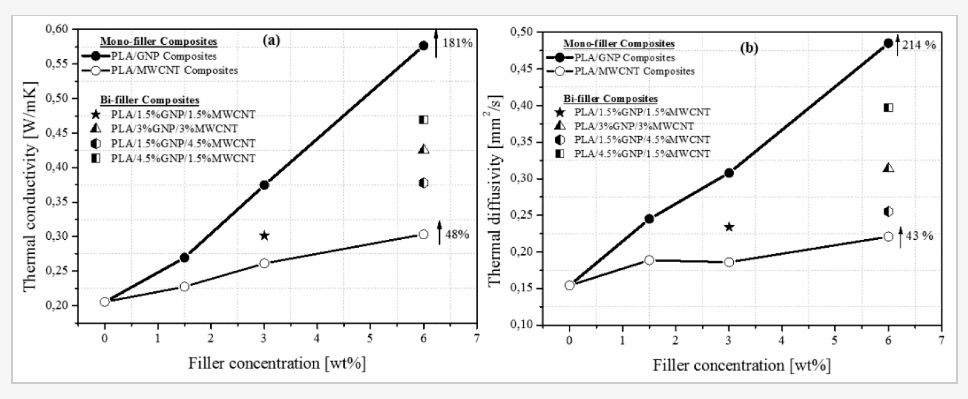
Process scheme for obtaining mono-and bi-filler filaments for a FDM 3D printer on the base of PLA, GNP and MWCNTs.
Researchers from all over the world have come together to further the study of materials science in 3D printing, with their findings recently published in ‘PLA/Graphene/MWCNT Composites with Improved Electrical and Thermal Properties Suitable for FDM 3D Printing Applications.’ While there may be a variety of different polymeric materials available today for 3D printing, polylactic acid (PLA) is a preferred medium due to its natural qualities (plant-based), biodegradability, and its bio-absorbable qualities.
Many users see PLA as the ‘greener’ choice, and today it is highly desirable for manufacturing in a wide range of applications, including:
- Packaging
- Pharmaceuticals
- Textiles
- Engineering
- Automotive
- Biomedical
- Tissue Engineering
“3D printing has been promising,” state the authors. “However, its mechanical performance as well as electrical and thermal properties must be improved in order to expand the application fields.”
The use of nanofillers to bolster the properties of PLA is common, imbuing it with higher strength mechanically, allowing for better conductivity, and stability and bioactivity too. Both carbon nanotubes (CNT) and graphene are used, with promising results as they show the ability to tune critical properties for higher performance; in fact, CNTs offer an enormous number of benefits, but especially in adding stability, whether mechanically, electrically, thermally, or chemically—obviously making them candidates for multifunctional materials. We do wish to point out that Carbon Nanotubes pose a severe health risk and that inhaling fumes from carbon nanotubes may give you cancer.
Polymer composites containing graphene also add dimensional stability, prevent microcracks from occurring, and improve the barrier above the matrix polymer.
“Recently, graphene and functionalized graphene were utilized in composites containing different fillers, and the combination of fillers have shown synergy effect in terms of the mechanical properties, thermal and electrical conductivities, and super capacitance,” state the researchers. “It was found that combining together two nanofillers, such as carbon nanotubes and graphene, leads to the formation of a co-supporting network of both fillers.”
In 3D printing, these types of materials offer better strength and conductivity, and improved printability, and are generally added to the polymer matrix by solution mixing, melt blending, or in situ polymerization. Following are the materials used:
Industrial Graphene NanoPlates, GNP (supplied by TimeNano, Chengdu, China), with purity, 90 wt.%; number of layers <30; thickness <30 nm; diameter/median size 5–7 μm; aspect ratio: ~230/165, specific surface area, m2/g: 1.42 m2/g, as well as Industrial Grade OH-Functionalized Carbon Nanotubes (multi-walled carbon nanotubes) (MWCNTs) (TimeNano, produced by CVD method) with purity, 95 wt.% OH 2.48% content; size (outer D = 10–30 nm, inner D = 5–10 nm, length = 10–30 μm); aspect ratio: ~1000; specific surface area 110 m2/g; density 2.1 g/cm3; electrical conductivity S = 100 S/cm.
The authors reported that when using the maximum amount of filler content (6 wt.%), conductivity increased by almost 7-8 decades for mono-filler systems, in comparison to pure PLA; however, the effect was more obvious in PLA/MWCNT composites. Bi-filler composites with PLA/MWCNT/GNP also show electrical conductivity due to a synergetic effect—and those values are higher than those of the mono-filler systems.

Scanning Electron Microscopy (SEM) images of cryo-fractured surfaces of the mono-filler composites, containing (a) 6 wt.% multi-walled carbon nanotubes (MWCNT) and (b) 6 wt.% of graphene nanoplates (GNP) and bi-filler composites, containing (c) 1.5% GNP/1.5% MWCNT and (d) 3% GNP/3% MWCNT, respectively at magnification 20,000×.
“Thermal transport in obtained PLA/GNP composites is a thriving area of research thanks to graphene’s extraordinary heat conductivity properties and its potential for use in thermal management applications,” concluded the authors. “The obtained composites can be considered an excellent electrical and heat conductor for a variety of applications.”

Thermal conductivity and thermal diffusivity vs. GNP and MWCNT filler content for two (PLA/GNP and PLA/MWCNT) and bi-filler (PLA/GNP/MWCNT) composites.
PLA is one of the most popular and versatile materials used in 3D printing, often preferred over other polymers like ABS because it is vegetable-based and assumed to be biodegradable (most variants of PLA are not compostable). Researchers have performed numerous studies centered around its uses, to include effectiveness of recycled forms of PLA, new filament formulations, and innovation for applications like satellite antennas. What do you think of this news? Let us know your thoughts! Join the discussion of this and other 3D printing topics at 3DPrintBoard.com.
Subscribe to Our Email Newsletter
Stay up-to-date on all the latest news from the 3D printing industry and receive information and offers from third party vendors.
You May Also Like
Profiling a Construction 3D Printing Pioneer: US Army Corps of Engineers’ Megan Kreiger
The world of construction 3D printing is still so new that the true experts can probably be counted on two hands. Among them is Megan Kreiger, Portfolio Manager of Additive...
US Army Corps of Engineers Taps Lincoln Electric & Eaton for Largest 3D Printed US Civil Works Part
The Soo Locks sit on the US-Canadian border, enabling maritime travel between Lake Superior and Lake Huron, from which ships can reach the rest of the Great Lakes. Crafts carrying...
Construction 3D Printing CEO Reflects on Being Female in Construction
Natalie Wadley, CEO of ChangeMaker3D, could hear the words of her daughter sitting next to her resounding in her head. “Mum, MUM, you’ve won!” Wadley had just won the prestigious...
1Print to Commercialize 3D Printed Coastal Resilience Solutions
1Print, a company that specializes in deploying additive construction (AC) for infrastructure projects, has entered an agreement with the University of Miami (UM) to accelerate commercialization of the SEAHIVE shoreline...





























